Digital Poster
Traditional Image Reconstruction
ISMRM & ISMRT Annual Meeting & Exhibition • 10-15 May 2025 • Honolulu, Hawai'i

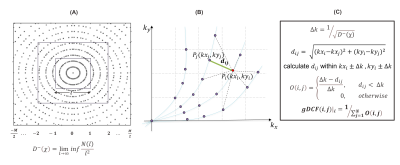 |
Computer Number: 17
4443. Geometrically-derived
Density Compensation Function for Non-Cartesian k-space Sampling
Trajectories in MRI
O. Aboyewa, D. Kim, K. Hong
Northwestern University, Evanston, United States
Impact: MRI acquisition using non-Cartesian sampling
trajectories has potential benefits for rapid imaging and
mitigating motion artifacts. The new gDCF enhances the image
reconstruction of any 2D non-Cartesian MRI acquisitions,
thus increasing their utility in patient scan.
|
|
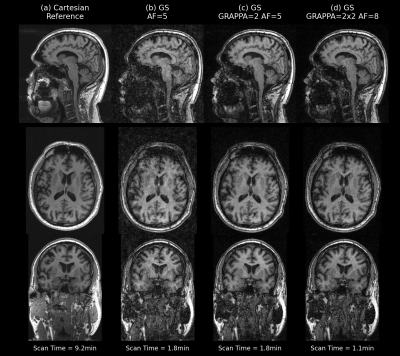 |
Computer Number: 18
4444. Bringing
GRAPPA to non-Cartesian MRI through SPARKLING: An application to
MP-RAGE anatomical MRI
C. G R, A. Vignaud, M. Bertrait, A. Massire, M. Bottlaender,
P. Ciuciu
CEA Paris Saclay, Gif-sur-Yvette, France
Impact: This novel technique will help bring
conventional multi-coil acceleration to non-Cartesian
imaging, which can be used independently to massively
accelerate MR scans, enabling faster and higher resolution
imaging, which will be beneficial for varied clinical
applications.
|
|
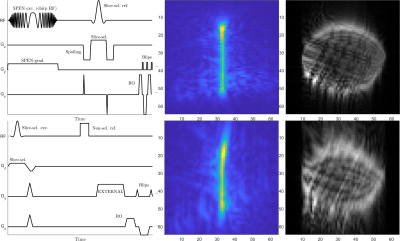 |
Computer Number: 19
4445. SPEN
with Non-linear Gradient Implementation using Pulseq
A. Holl, M. Zaitsev, F. Zijlstra, S. Littin
Division of Medical Physics, Department of Diagnostic and Interventional Radiology, University Medical Center Freiburg, Faculty of Medicine, University of Freiburg, Freiburg, Germany, Freiburg, Germany
Impact: Non-linear gradient-based
spatiotemporal-encoding overcomes SAR-limitations resulting
from the use of chirp-RF pulses for quadratic phase profile
generation, while providing comparable results, making
clinical application feasible.
|
|
 |
Computer Number: 20
4446. Improved
extraction of temporal basis from fully sampled fMRI data using
a combined ICA and SVD approach
C. Marchini, B. Sutton
University of Illinois Urbana-Champaign, Urbana, United States
Impact: Basis functions from SVD and ICA can be combined
to capture nongaussian signals at very low ranks when SVD
alone does not. Potential applications include reducing scan
time for low TR partial separability MRI reconstructions.
|
|
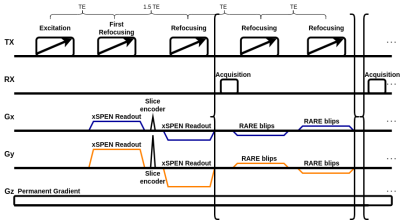 |
Computer Number: 21
4447. 3D
RARE Radial xSPEN and Inverse Radon Transform based
reconstruction for Single-Sided MRI
R. Jin, M. Gomes, M. Sadinski, A. Nacev, W. Grissom
Promaxo, Oakland, United States
Impact: This method is applicable for 3D imaging in an
inhomogeneous magnetic field at higher resolution compared
to traditional Fourier encoding by cropping the FOV without
aliasing.
|
|
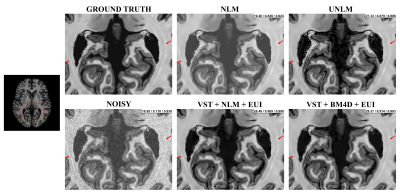 |
Computer Number: 22
4448. Optimized
variance-stabilizing and exact unbiased inverse transforms for
the non-central Chi distribution: application in MRI image
denoising
V. Campos, M. Vieira, A. Foi
University of São Paulo, São Carlos, Brazil
Impact: Magnitude
image is the most common data format in MRI clinical
settings. Our method allows denoising of magnitude MRI in a
way that one can properly use any off-the-shelf Gaussian
denoiser without the need to modify its core algorithm.
|
|
 |
Computer Number: 23
4449. A
template-based customization approach for compensating missing
brain MRI sequences in people with multiple sclerosis
O. Oladosu, X. Wang, Y. Zhang
University of Calgary, Calgary, Canada
Impact: Robust synthetization of unavailable brain MRI
sequences is essential in various secondary analytic tasks
including machine learning for advanced disease
characterization and monitoring, which can benefit people
with different diseases beyond multiple sclerosis.
|
|
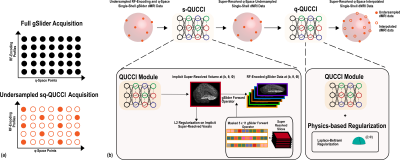 |
Computer Number: 24
4450. Super-resolution
across RF-encoding and q-space dimensions via physics-driven
neural fields for accelerated gSlider diffusion MRI
A. Topcu, C. Liao, T. Çukur, K. Setsompop, E. Saritas
Bilkent University, Ankara, Turkey
Impact: sq-QUCCI enables
collection of whole-brain high-spatial/angular-resolution,
high-SNR diffusion MRI data in a 15-min scan by
super-resolving across RF-encoding and q-space dimensions of
undersampled gSlider acquisitions, overcoming the efficiency
barrier for adoption in clinical settings.
|
|
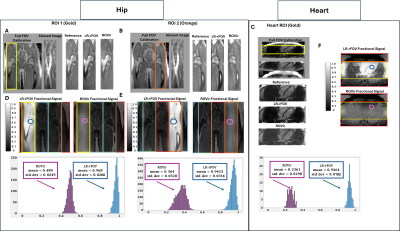 |
Computer Number: 25
4451. A
Comparison between Low Rank Reduced FOV and Region Optimized
Virtual Coils Reconstructions
F. Ali, J. Kim, Z. Zhang, M. Bydder, J. P. Finn, X. Li
The Cleveland Clinic Foundation, Cleveland, United States
Impact: LR-rFOV provides better outside signal
suppression and better preserves ROI signal than ROVir.
This approach enables one to save time at the scanner by
only prescribing the FOV over the desired ROI.
|
|
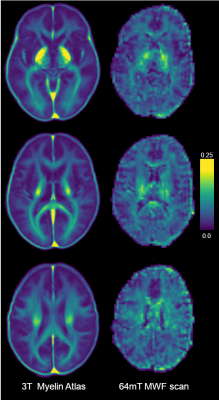 |
Computer Number: 26
4452. Myelin
water imaging from an 8 minute scan at 64mT via image
reconstruction and multicomponent T2 fitting in a low-rank space
N. Wiley, S. Balaji, M. Poorman, R. Teixeira, F. Padormo, H.
Liu, A. Dvorak, A. Traboulsee, S. Williams, S. Deoni, A.
Mackay, S. Kolind
University of British Columbia, Vancouver, Canada
Impact: Reconstruction and multi-component fitting in a
low-rank space allows myelin water fraction mapping at 64mT,
permitting quantitative ultra low-field measurements of
brain development in infants and children and demyelination
during the course of diseases like multiple sclerosis.
|
|
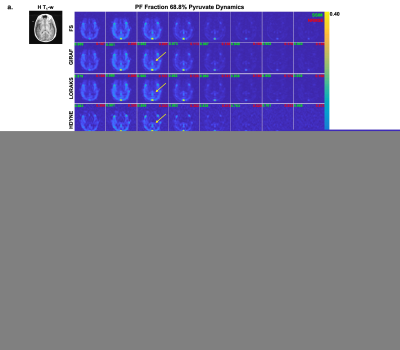 |
Computer Number: 27
4453. Low
Rank Reconstruction Enabled Partial Fourier 2D Dynamic Variable
Resolution Hyperpolarized 13C Imaging
T. Nickles, H-Y Chen, Y. Kim, X. Lui, P. Larson, D.
Vigneron, J. Gordon
University of California San Francisco , San Francisco, United States
Impact: Asymmetrical PF encoding of 2D dynamic HP [1-13C]pyruvate
MRI benefits from low-rank recovery reconstruction methods
to ensure image fidelity, and to increase SNR by reducing T2*
weighting.
|
|
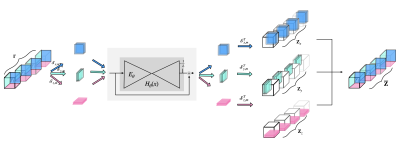 |
Computer Number: 28
4454. Fast
multi-contrast MRI using joint multiscale energy model
N. Yaghoobi, J. Rikhab Chand, Y. Chen, S. Kecskemeti, J.
Holmes, M. Jacob
University of Virginia, Charlottesville, United States
Impact:
The algorithm offers a 4x reduction in scan time and is over 10 times faster than current gridding-based non-linear fitting methods. J-MuSE is a good fit for general multicontrast applications by exploiting the correlations between contrasts, while enabling fast recovery. |
|
 |
Computer Number: 29
4455. Model-Based
Reconstruction for Joint Estimation of Multiple Quantitative
Maps in the Liver Using Single-Shot IR Multi-Echo Radial FLASH
V. Telezki, D. Mackner, N. Scholand, Z. Tan, M. Blumenthal,
P. Schaten, X. Wang, M. Uecker
University Medical Center Göttingen, Göttingen, Germany
Impact: By combining a highly sensitive sequence with
model-based reconstructions, this work reduces acquisition
times for quantitative water-specific $$$T_1$$$,
$$$R_2^∗$$$, $$$B_0$$$ field and fat-fraction maps to 4s and
makes quantitative multi-parametric MRI more accessible and
convenient for diagnostic purposes.
|
|
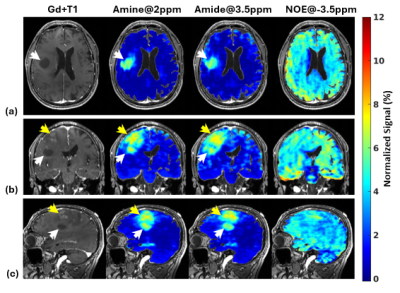 |
Computer Number: 30
4456. Robust
nonlinear parameter estimation with physics-enforced
spectral-spatial priors for multi-pool CEST analysis
C. Nguyen, R-E Yoo, S. H. Choi, J. Park
Sungkyunkwan University, Suwon, Korea, Republic of
Impact: The proposed method yields robust multi-pool
CEST spectral analysis even with highly incomplete
measurements, enabling whole brain CEST MRI (1.8mm$$$^3$$$)
in less than 4 minutes.
|
|
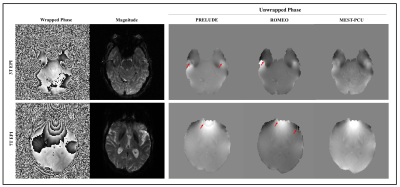 |
Computer Number: 31
4457. A
Morphology-Enabled Predictor Corrector Algorithm for Gradient
Echo MRI Phase Unwrapping
D. Kurian, G. Hagberg, K. Scheffler, S. Maurya, J. Paul
Digital University Kerala, Trivandrum, India
Impact: The MEST-PCU method enhances phase unwrapping by
integrating morphological information, providing a more
accurate and robust solution, particularly at high magnetic
field strengths. This method improves QSM estimation even
from later echoes, enabling effective susceptibility source
separation.
|
|
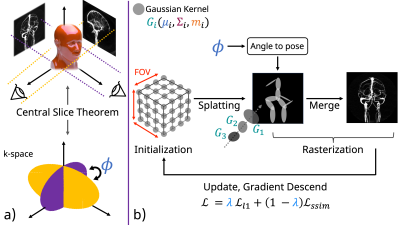 |
Computer Number: 32
4458. Volume
reconstruction and view synthesis from 2D projection MRI using
3D Gaussian Splatting
E. Yagiz, B. Tasdelen, N. Lee, K. Nayak
University of Southern California, Los Angeles, United States
Impact: We demonstrate a new approach for MRI volume
synthesis based on multiple projections (e.g. spiral
projection imaging), using noise-less neuroimaging
simulations. This has the potential to enable shorter scans
and/or better imaging in low signal-to-noise settings.
|
The International Society for Magnetic Resonance in Medicine is accredited by the Accreditation Council for Continuing Medical Education to provide continuing medical education for physicians.